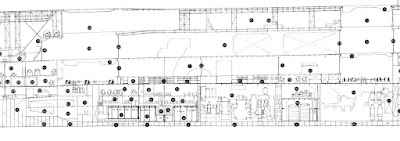Click on the pictures below to enlarge them
There were discussions on various internet forums about the purpose of platforms on top of after elevator wells of IJN aircraft carriers "Akagi" (see above), "Kaga" and "Ryujo".
Usual answer was - those are double elevators, similar to those on HMS "Ark Royal".I’ll show, that those are not double elevators, but 後部飛行機昇降台上部覆 = "after elevator top covers", placed to protect after elevator from being damaged by landing plane. It was impossible to lower them below level of flying deck.
Look at my drawing to see how it operated:



But were those things actually elevator covers?
Let’s start with the "Ryujo". I have several drawings of this ship, which say exactly the same thing: this ship had no double-level after elevator, but single-level elevator with a special elevator cover.



At the top view of "Ryujo" after elevator you can see 4 "ears", that protruded outside the elevator well to ensure elevator cover won’t fall at the bottom of the elevator well (see below).

The same "ears" can be seen on the after elevators of both "Akagi" (upper photo below) and "Kaga" (lower photo below).


On 1939 drawing of "Akagi" we can see see, that single-level middle elevator (captioned #90) is drawn in upper position flush with flying deck. Single-level aft elevator (also captioned #90) is at the bottom of the elevator well. BUT what's at at the top of the after elevator well? It is not captioned, but can be only elevator cover.

I’ve yet to see any official explanation for such an arrangement in any book on IJN aircraft carriers. But it’s not hard to guess, why it was used. After elevator area was the place, where aircraft have landed on those carriers. Even early aircraft were heavy and hit the deck hard. Apparently Japanese engineers were afraid, that such "kicks" will break after elevators, so they installed safety covers. Only the first IJN aircraft carrier "Hosho" received no such cover - probably because its landing area begun aft of the after elevator (see picture below).

The next generation of IJN carriers ("Soryu" (see picture below) and "Hiryu") also had their landing areas after the after elevators. Also by the time they were designed Japanese engineers, apparently, become sure the new elevator stoppers will be enough to prevent any accidents. So elevator covers never again appeared on IJN aircraft carriers.



On 1939 drawing of "Akagi" we can see see, that single-level middle elevator (captioned #90) is drawn in upper position flush with flying deck. Single-level aft elevator (also captioned #90) is at the bottom of the elevator well. BUT what's at at the top of the after elevator well? It is not captioned, but can be only elevator cover.

I’ve yet to see any official explanation for such an arrangement in any book on IJN aircraft carriers. But it’s not hard to guess, why it was used. After elevator area was the place, where aircraft have landed on those carriers. Even early aircraft were heavy and hit the deck hard. Apparently Japanese engineers were afraid, that such "kicks" will break after elevators, so they installed safety covers. Only the first IJN aircraft carrier "Hosho" received no such cover - probably because its landing area begun aft of the after elevator (see picture below).

The next generation of IJN carriers ("Soryu" (see picture below) and "Hiryu") also had their landing areas after the after elevators. Also by the time they were designed Japanese engineers, apparently, become sure the new elevator stoppers will be enough to prevent any accidents. So elevator covers never again appeared on IJN aircraft carriers.

Note, that elevator covers were retained on "Akagi", "Kaga" and "Ryujo" right to their sinking in 1942 (on the frame below elevator cover can be seen on "Kaga" (on the left side of the movie frame) in December 1941).

Sources: “Ryujo” drawings from S.Fukui collection (Kure Maritime Museum), “Akagi” drawing (Maru hardcover, drawings supplement, volume 1), H.Lengerer “Aircraft Carriers Of The Imperial Japanese Navy And Army” – Vol.1, Mechanism of Japanese Aircraft Carriers, Wikipedia photos.

Sources: “Ryujo” drawings from S.Fukui collection (Kure Maritime Museum), “Akagi” drawing (Maru hardcover, drawings supplement, volume 1), H.Lengerer “Aircraft Carriers Of The Imperial Japanese Navy And Army” – Vol.1, Mechanism of Japanese Aircraft Carriers, Wikipedia photos.

No comments:
Post a Comment